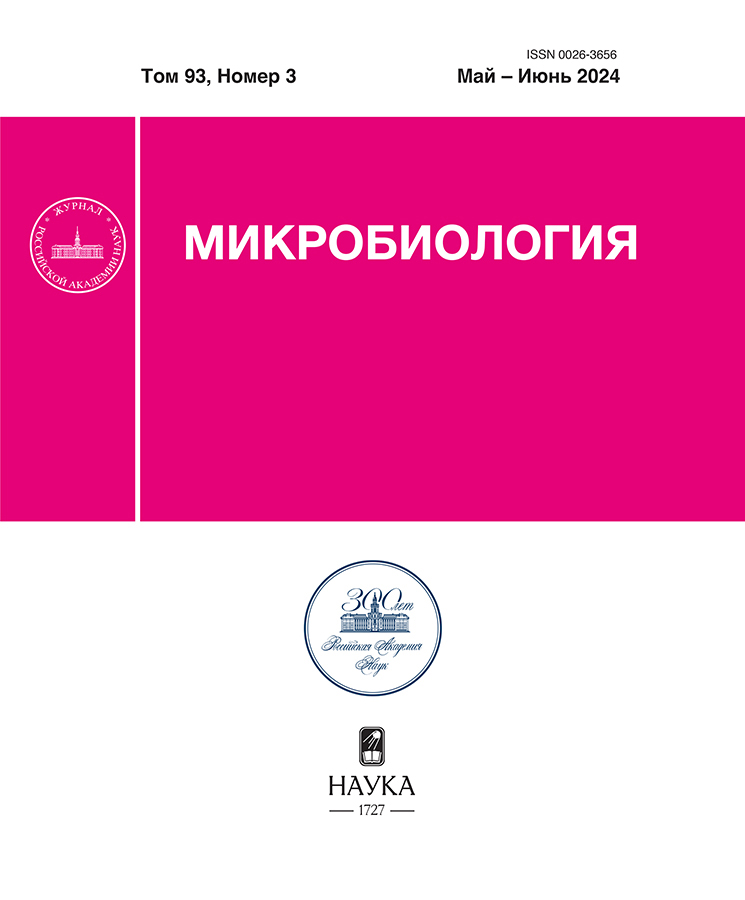Hydrocarbon-Oxidizing Bacteria of the Bottom Ecotopes of the Barents and Pechora Seas
- Authors: Pyrkin V.O.1, Gavirova L.A.1, Stroeva A.R.1, Merkel A.Y.2, Vidishcheva O.N.1, Kalmykov A.G.1, Bonch-Osmolovskaya E.A.1,2
-
Affiliations:
- Lomonosov Moscow State University
- Winogradsky Institute of Microbiology, Federal Research Center of Biotechnology, Russian Academy of Sciences
- Issue: Vol 93, No 3 (2024)
- Pages: 330-335
- Section: SHORT COMMUNICATIONS
- URL: https://jdigitaldiagnostics.com/0026-3656/article/view/655103
- DOI: https://doi.org/10.31857/S0026365624030081
- ID: 655103
Cite item
Abstract
Microorganisms capable of degrading hydrocarbons are regular components of natural microbial communities and play an important role in self-purification of marine environments from oil contamination. High-throughput sequencing of the 16S rRNA gene V4 variable region was used to analyze microbial communities of the Barents and Pechora seas and of the microcosms with a spectrum of hydrocarbon substrates: oil, n-nonane, n-undecane, and phenanthrene. The Barents Sea communities of hydrocarbon-oxidizing microorganisms were characterized by predominance of the genera Pseudoalteromonas, Pseudomonas, Porticoccus, and Oleispira, while those of the Pechora Sea contained members of the genera Rhodococcus, Dietzia, Sphingorhabdus, and Hyphomonas. Pure cultures of these microorganisms were shown to utilize the major oil hydrocarbons: n-alkanes, cycloalkanes, and aromatic compounds.
Full Text
About the authors
V. O. Pyrkin
Lomonosov Moscow State University
Author for correspondence.
Email: vladisluw@yandex.ru
Russian Federation, Moscow
L. A. Gavirova
Lomonosov Moscow State University
Email: vladisluw@yandex.ru
Russian Federation, Moscow
A. R. Stroeva
Lomonosov Moscow State University
Email: vladisluw@yandex.ru
Russian Federation, Moscow
A. Yu. Merkel
Winogradsky Institute of Microbiology, Federal Research Center of Biotechnology, Russian Academy of Sciences
Email: vladisluw@yandex.ru
Russian Federation, Moscow
O. N. Vidishcheva
Lomonosov Moscow State University
Email: vladisluw@yandex.ru
Russian Federation, Moscow
A. G. Kalmykov
Lomonosov Moscow State University
Email: vladisluw@yandex.ru
Russian Federation, Moscow
E. A. Bonch-Osmolovskaya
Lomonosov Moscow State University; Winogradsky Institute of Microbiology, Federal Research Center of Biotechnology, Russian Academy of Sciences
Email: vladisluw@yandex.ru
Russian Federation, Moscow; Moscow
References
- Гордадзе Г. Н., Гируц М. В., Пошибаева А. Р., Кошелев В. Н. Химия нефти с основами органической геохимии. М.: РГУ нефти и газа имени И. М. Губкина, 2015. 80 с.
- Еремин Н. А., Кондратюк А. Т., Еремин А. Н. Ресурсная база нефти и газа арктического шельфа России // Георесурсы, геоэнергетика, геополитика. 2010. № 1 (1). С. 23.
- Меркель А. Ю., Тарновецкий И. Ю., Подосокорская О. А., Тощаков С. В. Анализ систем праймеров на ген 16S рРНК для профилирования термофильных микробных сообществ // Микробиология. 2019. Т. 88. С. 655–664.
- Merkel A. Yu., Tarnovetskii I. Yu., Podosokorskaya O. A., Toshchakov S. V. Analysis of 16S rRNA primer systems for profiling of thermophilic microbial communities // Microbiology (Moscow). 2019. V. 88. P. 671–681.
- Патин С. А. Нефть и экология континентального шельфа. М.: Издательство ВНИРО, 2017. 284 с.
- Callahan B. J., McMurdie P.J., Rosen M. J., Han A. W., Johnson A. J.A., Holmes S. P. DADA2: High-resolution sample inference from Illumina amplicon data // Nature Methods. 2016. V. 13. P. 581–583.
- Caruso V., Song X., Asquith M., Karstens L. Performance of microbiome sequence inference methods in environments with varying biomass // MSystems. 2019. V. 4. https://doi.org/10.1128/msystems.00163–18.
- De Carvalho C. C.C.R., Costa S. S., Fernandes P., Couto I., Viveiros M. Membrane transport systems and the biodegradation potential and pathogenicity of genus Rhodococcus // Front. Physiol. 2014. V. 5. Art. 133.
- Fisher S. J., Alexander R., Kagi R. I., Oliver G. A. Aromatic hydrocarbons as indicators of biodegradation in north Western Australian reservoirs // Sedimentary Basins of Western Australia: West Australian Basins Symposium / Ed. Purcell P. G., Purcell R. R. Perth, 1998. P. 185–194.
- Gohl D. M., Vangay P., Garbe J., MacLean A., Hauge A., Becker A., Beckman K. B. Systematic improvement of amplicon marker gene methods for increased accuracy in microbiome studies // Nature Biotechnol. 2016. V. 34. P. 942–949.
- Hugerth L. W., Wefer H. A., Lundin S., Jakobsson H. E., Lindberg M., Rodin S., Andersson A. F. DegePrime, a program for degenerate primer design for broad-taxonomic-range PCR in microbial ecology studies // Appl. Environ. Microbiol. 2014. V. 80. P. 5116–5123.
- Lea-Smith D.J., Biller S. J., Davey M. P., Cotton C. A., Perez Sepulveda B. M., Turchyn A. V., Howe C. J. Contribution of cyanobacterial alkane production to the ocean hydrocarbon cycle // Proc. Natl. Acad. Sci. USA. 2015. V. 112. P. 13591–13596.
- Nõlvak H., Dang N. P., Truu M., Peeb A., Tiirik K., O’Sadnick M., Truu J. Microbial community dynamics during biodegradation of crude oil and its response to biostimulation in Svalbard seawater at low temperature // Microorganisms. 2021. V. 9. Art. 2425.
- Quast C., Pruesse E., Yilmaz P., Gerken J., Schweer T., Yarza P., Glöckner F. O. The SILVA ribosomal RNA gene database project: improved data processing and web-based tools // Nucl. Acids Res. 2012. V. 41. D1. P. D590–D596.
- Rogozhin V., Osadchiev A., Konovalova O. Structure and variability of the Pechora plume in the southeastern part of the Barents Sea // Front. Mar. Sci. 2023. V. 10. Art. 1052044.
- Wang X. B., Chi C. Q., Nie Y., Tang Y. Q., Tan Y., Wu G., Wu X. L. Degradation of petroleum hydrocarbons (C6–C40) and crude oil by a novel Dietzia strain // Bioresour. Technol. 2011. V. 102. P. 7755–7761.
Supplementary files












